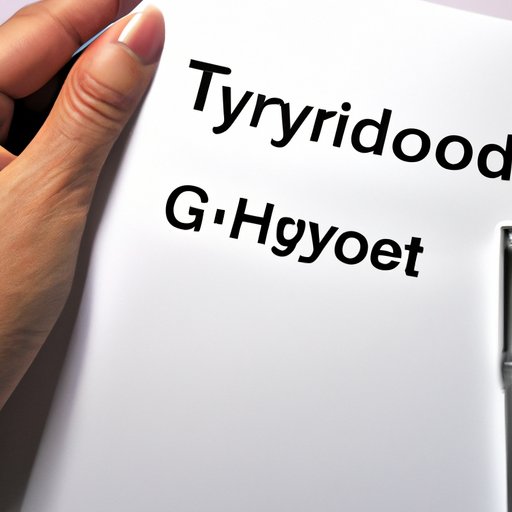
I. Introduction
Graves’ Disease is an autoimmune disorder that affects the thyroid gland, causing it to overproduce hormones. With the thyroid gland producing too many hormones, the person’s body systems speed up, leading to various symptoms. Graves’ Disease can be a life-altering diagnosis that can be both overwhelming and confusing.
This article provides a comprehensive guide to Graves’ Disease, covering symptoms, causes, diagnosis, treatment options, and management techniques to help those who have been recently diagnosed with the condition.
II. A Comprehensive Guide to Understanding Graves’ Disease
Graves’ Disease is a type of hyperthyroidism, which is a thyroid disorder resulting in the thyroid gland producing too many hormones. The thyroid gland is a small gland located in the front of the neck, responsible for hormone production that regulates metabolism and numerous body functions.
Graves’ Disease is named after Sir Robert Graves, an Irish doctor who discovered the disease in 1835. It is estimated that roughly 1 in every 200 people in the United States has Graves’ Disease, affecting mostly women and those over age 60.
III. Unpacking the Symptoms and Treatment Options for Graves’ Disease
The symptoms of Graves’ Disease can range from mild to severe and can affect specific systems of the body. Symptoms can include: weight loss, anxiety, tremors, rapid or irregular heartbeat, fatigue, sweating, intolerance to heat, double vision, enlargement of the thyroid gland, or bulging of the eyes.
The treatment for Graves’ Disease aims to reduce the body’s production of thyroid hormones. The three primary treatments include medication, radiation, or surgery. Anti-thyroid medications such as methimazole and propylthiouracil are the first line of treatment for most patients. However, radioactive iodine and surgery may be necessary for some patients. Additionally, alternative therapies such as acupuncture, yoga, and herbal therapy may be beneficial when used in conjunction with traditional methods.
While treatment options exist, Graves’ Disease presents a challenge for healthcare providers. The disease can be unpredictable, with symptoms developing rapidly or becoming severe before treatment can be provided.
IV. Graves’ Disease: Causes, Diagnosis, and Management
The exact cause of Graves’ Disease is unknown. Experts believe that it is an autoimmune disorder, which occurs when the immune system mistakenly attacks healthy body tissues. In Graves’ Disease, the immune system attacks the thyroid gland, which results in hyperthyroidism.
Diagnosis of Graves’ Disease begins with a physical exam and blood tests to measure thyroid hormone levels. If the hormone levels are high, other diagnostic tests such as a thyroid ultrasound or radioactive iodine uptake test may be performed.
Management of Graves’ Disease can be tricky, and successful treatment requires ongoing monitoring and medication adjustments. Healthcare providers may recommend thyroid function tests, which involve analyzing the thyroid hormone and thyroid-stimulating hormone levels in the blood. Additionally, managing stress levels and eating a healthy diet can help manage symptoms.
V. Living with Graves’ Disease: One Patient’s Experience
Living with Graves’ Disease can be a challenging and emotional journey, as the symptoms can be both physically and mentally exhausting. Patients with Graves’ Disease must learn to manage and cope with their symptoms continually. It’s a journey that requires patience, perseverance, and a strong support system to overcome the physical and emotional toll of the condition.
A patient with Graves’ Disease may experience challenges such as mood changes, fatigue, irritability, and muscle weakness. In contrast, some patients may feel cutting-edge anxiety, sweating, and unintended weight loss. Despite the challenges, some Graves’ Disease patients have learned to cope and manage their condition through exercise, stress management, and treatment.
VI. Exploring the Link Between Graves’ Disease and Thyroid Health
Thyroid health is integral to body functioning, and Graves’ Disease is a type of thyroid disorder. The thyroid gland produces two hormones known as T3 and T4, which helps the body regulate energy, growth, and temperature. When the thyroid gland is functioning well, the body will function accordingly.
There are two types of thyroid disorders: Hyperthyroidism and hypothyroidism. Hyperthyroidism results in the thyroid gland producing too many hormones, as evidenced by Graves’ Disease. Hypothyroidism, on the other hand, results in not producing enough hormones. Therefore, it is important to monitor thyroid health regularly and seek medical attention when symptoms arise.
VII. The Top 5 Misconceptions About Graves’ Disease: Debunked
Graves’ Disease is a misunderstood condition, leading to numerous misconceptions. These include:
- Graves’ Disease is not a real illness.
- Graves’ Disease is a rare condition.
- Graves’ Disease only affects the thyroid gland.
- Graves’ Disease is easily treated with medication alone.
- Graves’ Disease affects only women.
Debunking these misconceptions is essential to help people understand the realities of living with Graves’ Disease and the importance of early detection and treatment.
VIII. New Research and Findings on Graves’ Disease: What You Need to Know
Research on Graves’ Disease is ongoing, with experts frequently making new discoveries that help improve treatment and management outcomes. Researchers are also trying to determine what triggers the immune system to attack the thyroid gland and other body tissues.
In recent years, researchers have found links between Graves’ Disease and Vitamin D deficiencies, which can contribute to further illness. Additionally, researchers are also exploring holistic treatments such as acupuncture and meditation to help manage symptoms.
IX. Conclusion
Living with Graves’ Disease is a challenging journey that requires ongoing management and treatment. While there is no cure, it is possible to manage symptoms effectively. Regular monitoring and medication adjustments are key to effectively managing Graves’ Disease. With ongoing support, education, and treatment, those who have been diagnosed with the condition can live a fulfilling life and maintain good thyroid health.




